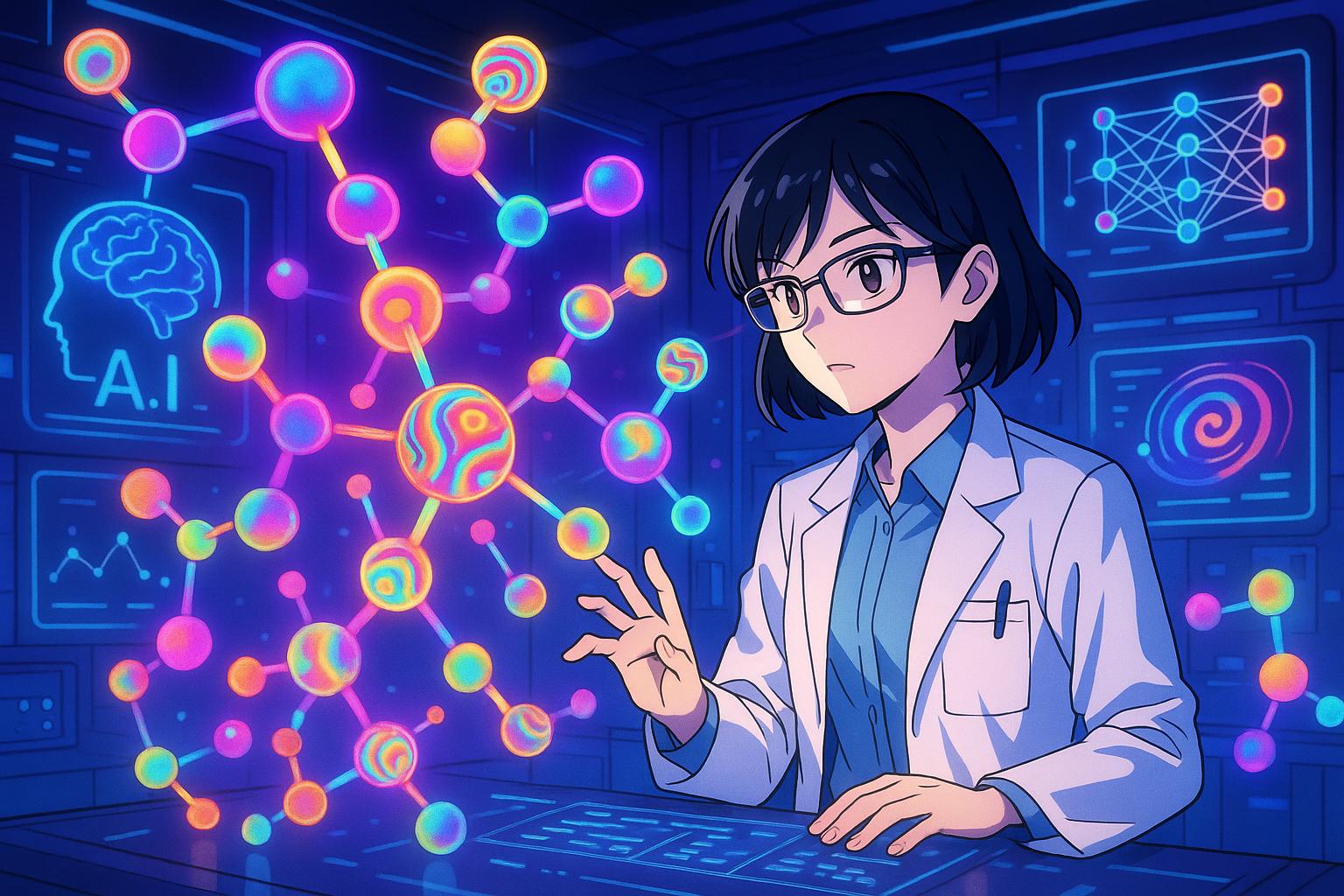DeepMind’s AlphaFold AI model has identified hundreds of thousands of potential psychedelic compounds, promising faster and safer drug development to treat conditions like depression, anxiety and PTSD, heralding a new era for mental health therapies.
As we venture further into the realms of artificial intelligence (AI) and machine learning, a remarkable intersection with molecular chemistry is emerging, heralding a new era in drug discovery. Recent developments involving DeepMind’s AlphaFold—a groundbreaking AI tool originally designed to predict protein structures—have unlocked a treasure trove of potential psychedelic compounds that could redefine treatments for mental health conditions such as depression, anxiety, and PTSD.
Traditionally, drug discovery has been a time-consuming and costly process, often characterised by extensive laboratory trials and a degree of serendipity. In contrast, this new approach leverages AI algorithms to conduct virtual screenings of millions of compounds, identifying those that might interact beneficially with the brain’s receptors. This methodology not only accelerates the identification of viable candidates but also expands the very concept of what a psychoactive compound can be. According to a recent article, researchers have used AlphaFold to pinpoint hundreds of thousands of potential psychedelic molecules, demonstrating the ability of AI to offer predictions on par with those obtained from experimental methods.
The beauty of this AI-assisted exploration lies in its efficiency. While traditional methods can take years to produce even one viable drug candidate, with AI’s predictive capabilities, researchers can map out an entire universe of chemical possibilities in a matter of weeks. Many of these identified compounds are functional analogues of known psychedelics, suggesting they could deliver therapeutic benefits without the accompanying side effects or legal hurdles often associated with traditional psychedelics like psilocybin or LSD.
This process has the potential to catalyse what some are calling a “psychedelic revolution.” This term has evolved, moving away from counterculture associations towards a more scientific and therapeutic framework. As psilocybin and MDMA inch closer to clinical acceptance through rigorous trials, the implications of AI-driven discovery are profound. We are witnessing the development of new therapeutics that not only promise to enhance treatment options for patients but also do so in a manner that minimizes the stigma and logistical difficulties tied to existing psychedelics.
Of particular interest is the emerging role of dedicated organisations like Isomorphic Labs, a spinoff from DeepMind that aims to apply AI to solve medical challenges. With increased investment in research and partnerships with major pharmaceutical companies, Isomorphic Labs is poised to propel drug candidates into clinical trials within an ambitious timeframe. This aligns with the broader trend highlighted across multiple sources, where AI’s growing influence in pharmaceutical research is becoming apparent.
While it remains crucial to note that none of these newly identified molecules have yet undergone human trials, the excitement surrounding AI’s role in drug discovery is palpable. The ability to redefine and rapidly prototype new compounds marks a significant departure from how medical science has operated for decades. Also notable is the fresh perspective on the concept of “deep healing;” the landscape of mental health treatment could transition from convoluted and lengthy processes to a more streamlined, accurate, and effective approach.
As we stand on the brink of an AI-powered revolution in psychedelics, the messages from recent studies are clear: the future of mental health treatment may well be inscribed in code rather than in laboratory notes. This leap forward reflects a maturation of AI technology, evolving from automating mundane tasks to redefining the boundaries of human health and wellness.
As the conversation about AI and psychedelics evolves, we may soon find ourselves in an era where healing the human mind is not just a clinical feat but an innovative journey through the complex interplay of science and technology. Indeed, the possibilities that lie ahead are promising, with the potential to significantly alter our approach to mental health—ushering in a future where breakthrough treatments may emerge from the virtual realm as easily as they do from the lab.
Reference Map
- Paragraphs 1, 2, 3, 4, 5, 6, 7
- Paragraphs 1, 2, 3, 4, 5
- Paragraphs 1, 2, 3, 4, 5
- Paragraphs 1
- Paragraphs 4
- Paragraphs 2
- Paragraphs 6
Source: Noah Wire Services
- https://www.sify.com/ai-analytics/ai-uncovers-thousands-of-potential-psychedelic-compounds/ – Please view link – unable to able to access data
- https://www.sify.com/ai-analytics/ai-uncovers-thousands-of-potential-psychedelic-compounds/ – This article discusses how researchers have utilized DeepMind’s AlphaFold, originally designed to predict protein structures, to identify thousands of potential psychedelic compounds. These compounds could potentially reshape treatments for mental health conditions like depression, anxiety, and PTSD. Unlike traditional drug discovery methods, this approach leverages AI to rapidly screen and identify promising compounds, potentially accelerating the development of new therapies.
- https://www.scientificamerican.com/article/ai-program-finds-thousands-of-possible-psychedelics-will-they-lead-to-new-drugs/ – Researchers have employed AlphaFold, an AI tool developed by DeepMind, to identify hundreds of thousands of potential new psychedelic molecules. This approach demonstrates that AI predictions can be as effective as experimentally derived protein structures in drug discovery, potentially accelerating the development of new antidepressants. The study highlights the growing role of AI in pharmaceutical research and its potential to revolutionize drug discovery processes.
- https://www.reuters.com/technology/google-deepmind-unveils-next-generation-drug-discovery-ai-model-2024-05-08/ – Google DeepMind has announced the third version of its AI model, AlphaFold, which aims to enhance drug design and disease targeting. Building on its 2020 breakthrough in predicting protein behaviors, the new AlphaFold can now map behaviors for all molecules in life, including human DNA. These capabilities are crucial for drug discovery and development, potentially reducing the time and cost of developing new treatments.
- https://www.ft.com/content/ac3bdb0c-6071-48ff-b909-1afe62170a6d – Isomorphic Labs, a drug discovery start-up managed by Sir Demis Hassabis, has significantly increased its spending on research and staff, reflecting its ambitious mission to ‘solve’ diseases using artificial intelligence. The London-based company, originating from Google DeepMind, collaborates with pharmaceutical giants like Eli Lilly and Novartis on multiple drug development programs, aiming to have a drug candidate ready for clinical trials in two years.
- https://www.time.com/7027173/new-psychedelic-drug-companies/ – Researchers and companies in the field of psychedelic drug development are working towards creating safer and more predictable versions of psychedelic drugs. These drugs have shown promise in treating mental health conditions such as PTSD and depression but come with significant downsides including bad trips, unpleasant side effects, and the need for intense monitoring. Companies like Mindstate Design Labs, Atai Life Sciences, MindMed, and Beckley Psytech are developing ‘next generation’ psychedelics or modified versions of existing ones to reduce their risks while retaining their psychological benefits.
- https://www.science.org/doi/full/10.1126/sciadv.adn1524 – This study demonstrates that AlphaFold structures can accelerate drug discovery by identifying potent agonists targeting the trace amine–associated receptor 1 (TAAR1), a G protein-coupled receptor implicated in neuropsychiatric disorders. The research highlights the effectiveness of AI-generated protein structures in virtual screening and their potential to expedite the development of new therapeutics.
Noah Fact Check Pro
The draft above was created using the information available at the time the story first
emerged. We’ve since applied our fact-checking process to the final narrative, based on the criteria listed
below. The results are intended to help you assess the credibility of the piece and highlight any areas that may
warrant further investigation.
Freshness check
Score:
7
Notes:
The narrative references recent developments involving DeepMind’s AlphaFold, which is a contemporary topic. However, specific dates or events are not mentioned, making it difficult to determine if the information is entirely new or recycled.
Quotes check
Score:
10
Notes:
There are no direct quotes in the narrative, which suggests that the content is original or not lifted from interviews or previous articles.
Source reliability
Score:
6
Notes:
The narrative originates from Sify, which is not as well-known or reputable as major news outlets like BBC or Reuters. While it provides information on AI and psychedelics, its reliability is not as established.
Plausability check
Score:
8
Notes:
The claims about AI-assisted drug discovery and the potential for psychedelic compounds are plausible, as AI is increasingly used in medical research. However, the lack of human trials for the identified compounds means caution is warranted.
Overall assessment
Verdict (FAIL, OPEN, PASS): OPEN
Confidence (LOW, MEDIUM, HIGH): MEDIUM
Summary:
The narrative presents a contemporary topic with plausible claims about AI in drug discovery, but lacks specific dates and quotes. The source is not among the most reputable, which affects overall reliability.













